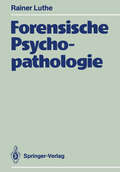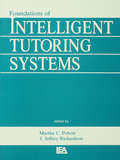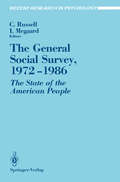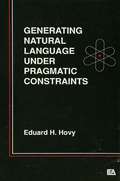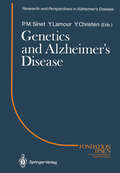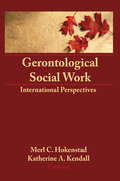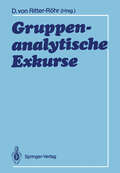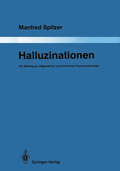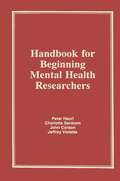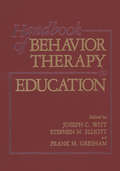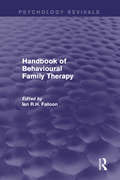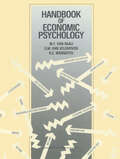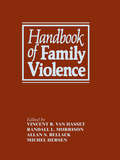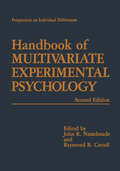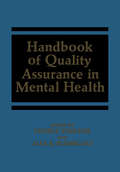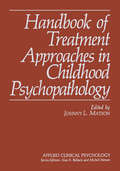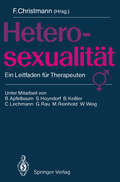- Table View
- List View
The First Compendium of Social Network Research Focusing on Children and Young Adult: Social Networks of Children, Adolescents, and College Students
by Suzanne Salzinger John Antrobus Muriel HammerResearch on adult personal-social networks has contributed greatly to an understanding of mental health, illness, and responses to stress. Fueled by this successful research and a growing concern for today's youth, the contributors to this volume have conducted investigations into the functioning and structures of the social networks of toddlers, school-age children, adolescents, and college students. The editors of this volume move beyond vague generalizations about characteristic and behavior acquisition through socialization in childhood by applying a longitudinal perspective to the sampling of child, adolescent, and young-adult network research. Social Networks of Children, Adolescents, and College Students unites several major empirical studies of children's social networks, investigating the acquisition of specific behaviors from particular groups of individuals under certain conditions. Topics covered include: * the effects of social networks on child development and disorder * the relationship between social networks and coping with stress the role of friends or groups in positive socialization * Of special interest to practitioners, researchers, and advanced students are: * comparative data on children from other cultural groups and non-mainstream American youths descriptions and evaluations of methodologies * introductory materials by the editors commenting on the field and the research extensive bibliographies
Forensische Psychopathologie
by Rainer LuthePsychopathologie wird dadurch zur interdisziplinären Wissenschaft, daß sie spezifisch psychopathologische Fragen, wie die nach der Schuldfähigkeit, systematisch beantworten kann. Bislang unterstellten psychiatrische Phänomenologen quasi-objektive, "reine" Inhalte geistiger Art ("Wesensschau"), die nur beschrieben, in ihrer grenzenlosen Vielfalt aber systematisch erfaßt werden können. Gleichwohl wurden sie den im forensischen Dialog eingeführten Begriffen zugrundegelegt. Erkenntnistheoretische Besinnung geht von Kant aus und zeigt, daß Phänomene dem Erkennen nicht fertig vorgegeben sind, sondern (in der Sprache) hergestellt werden. Erst durch Untersuchung der Herstellungsprinzipien wird Phänomenologie formalisiert und Psychopathologie - mit den über ihre praktische Brauchbarkeit entscheidenden Kontrollmöglichkeiten - systematisch. Das Buch trägt den Entwicklungen der letzten 15 Jahre auf dem Gebiet der forensischen Psychiatrie Rechnung. Es erfüllt die Funktion eines grundlegenden Lehrbuches der gerichtlichen Psychologie und Psychiatrie.
Foundations of Intelligent Tutoring Systems (Interacting with Computers Series)
by Martha C. Poison, J. Jeffrey RichardsonThis collection of essays -- each of which treats an integral aspect of the field -- defines several key concepts and their interrelationships, outlines basic research issues, and discusses near-term applications projects. The book examines three foundations of ITSs in detail -- expert, student diagnostic, and instructional or curricular knowledge -- and describes: * How they are embodied in computer-assisted instructional environments * How these systems accrue the advantages of advanced computer interface technologies * How ITSs will emerge in the real world of complex problem solving * How researchers must learn to evaluate the effectiveness and overall quality of these dynamic systems in a world where machine tutoring may one day be taken for granted. Justine Wise Polier (1903-1987) was educated at Bryn Mawr, Radcliffe, and Barnard. She earned her law degree from Yale Law School where she was editor of the Yale Law Journal. In 1935, she was appointed Justice of the Family Court where she sat for 38 years. Judge Polier took a leave from the bench in 1941 when she was appointed special advisor to Eleanor Roosevelt at the Office of Civilian Defense in Washington. She also served as Chairman of the Committee on Mental Health for New York. Judge Polier was a founder and president of the Wiltwyck School; vice president of the Citizens Committee for Children of N.Y.; vice president of the American Jewish Congress; Delegate to the White House Conferences on Children and on Education. Judge Polier was a member of the Institute of Judicial Administration, American Bar Association. She was on the editorial board of the International Juridical Association and was awarded the 1964 Isaac Ray Award by the American Psychiatric Association for "contributions to the improvement of the relations of Law and Psychiatry." Following her retirement from the bench, she served as the director of the Juvenile Judge division of the Children's Defense Fund. During her illustrious career, Judge Polier was the recipient of numerous awards including: the Citation for Distinguished Service to the City of New York, 1973; the Human Services Award from the New York and Bronx Mental Health Association, 1973; the Eleanor Roosevelt Humanitarian Award from the Board of Directors of Wiltwyck School, 1975. Judge Polier also published numerous reports and several books including: Everyone's Children, Nobody's Child; Back to What Woodshed?; A View from the Bench; and The Rule of Law and the Role of Psychiatry.
Foundations of Intelligent Tutoring Systems (Interacting with Computers Series)
by Martha C. Polson J. Jeffrey RichardsonThis collection of essays -- each of which treats an integral aspect of the field -- defines several key concepts and their interrelationships, outlines basic research issues, and discusses near-term applications projects. The book examines three foundations of ITSs in detail -- expert, student diagnostic, and instructional or curricular knowledge -- and describes: * How they are embodied in computer-assisted instructional environments * How these systems accrue the advantages of advanced computer interface technologies * How ITSs will emerge in the real world of complex problem solving * How researchers must learn to evaluate the effectiveness and overall quality of these dynamic systems in a world where machine tutoring may one day be taken for granted. Justine Wise Polier (1903-1987) was educated at Bryn Mawr, Radcliffe, and Barnard. She earned her law degree from Yale Law School where she was editor of the Yale Law Journal. In 1935, she was appointed Justice of the Family Court where she sat for 38 years. Judge Polier took a leave from the bench in 1941 when she was appointed special advisor to Eleanor Roosevelt at the Office of Civilian Defense in Washington. She also served as Chairman of the Committee on Mental Health for New York. Judge Polier was a founder and president of the Wiltwyck School; vice president of the Citizens Committee for Children of N.Y.; vice president of the American Jewish Congress; Delegate to the White House Conferences on Children and on Education. Judge Polier was a member of the Institute of Judicial Administration, American Bar Association. She was on the editorial board of the International Juridical Association and was awarded the 1964 Isaac Ray Award by the American Psychiatric Association for "contributions to the improvement of the relations of Law and Psychiatry." Following her retirement from the bench, she served as the director of the Juvenile Judge division of the Children's Defense Fund. During her illustrious career, Judge Polier was the recipient of numerous awards including: the Citation for Distinguished Service to the City of New York, 1973; the Human Services Award from the New York and Bronx Mental Health Association, 1973; the Eleanor Roosevelt Humanitarian Award from the Board of Directors of Wiltwyck School, 1975. Judge Polier also published numerous reports and several books including: Everyone's Children, Nobody's Child; Back to What Woodshed?; A View from the Bench; and The Rule of Law and the Role of Psychiatry.
Fuzzy Sets in Psychology (ISSN #Volume 56)
by T. ZetenyiThis volume provides an up-to-date picture of the current status of theoretical and empirical developments in the application of fuzzy sets in psychology. Fuzzy set theory could benefit researchers in at least two ways: first, as a metaphor or model for ordinary thought, and secondly, as an aid to data analysis and theory construction. One can find examples for both kinds in the volume, which will be of interest both to the advanced student in the field as well as to anyone possessing a basic scientific background.
The General Social Survey, 1972–1986: The State of the American People (Recent Research in Psychology)
by Charlos H. Russell Inger MegaardThis book is the first comprehensive summary of the General Social Survey since its origin in 1972. Topics range over the whole subject matter of the GSS, from political behavior and attitudes to the mores, psychological states, and socio-economic characteristics of the American public. This volume provides a quick reference guide to the major questions asked in the GSS. Summaries for all respondents appear along with breakdowns by gender and standard age categories (age 18 - 85). The list of tables and the index offer readers convenient access to specific questions while the topical arrangement of the tables provides a coherent presentation of related subjects. For those unfamiliar with the GSS this will serve as an exciting and comprehensive introduction. Students in sociology, psychology, political science, economics, American studies, family studies, aging, social work, and health fields will find it an exceptional source of information. For researchers, the book provides a simplified reference to the GSS and data for statistical treatment in analytical studies.
Generating Natural Language Under Pragmatic Constraints
by Eduard H. HovyRecognizing that the generation of natural language is a goal- driven process, where many of the goals are pragmatic (i.e., interpersonal and situational) in nature, this book provides an overview of the role of pragmatics in language generation. Each chapter states a problem that arises in generation, develops a pragmatics-based solution, and then describes how the solution is implemented in PAULINE, a language generator that can produce numerous versions of a single underlying message, depending on its setting.
Generating Natural Language Under Pragmatic Constraints
by Eduard H. HovyRecognizing that the generation of natural language is a goal- driven process, where many of the goals are pragmatic (i.e., interpersonal and situational) in nature, this book provides an overview of the role of pragmatics in language generation. Each chapter states a problem that arises in generation, develops a pragmatics-based solution, and then describes how the solution is implemented in PAULINE, a language generator that can produce numerous versions of a single underlying message, depending on its setting.
Genetics and Alzheimer’s Disease: Colloque Medecine et Recherche 2. Meeting Paris 1988 (Research and Perspectives in Alzheimer's Disease)
by Pierre M. Sinet Yvon LamourThis volume contains the proceedings of the meeting Genetics and Alzheimer's Disease held in Paris, on March 25,1988, by the Fondation Ipsen pour la Recherche Therapeuti que. This meeting was the second of the series of Colloques Medecine et Recherche devoted to Alzheimer's disease. The first one was held in Angers (France) on September 14, 1987; the proceedings of this meeting have already been published and are entitled Immunology and Alzheimer's Disease (1988, edited by A Pouplard-Barthelaix, J Emile, and Y Christen). The third Colloque Medecine et Recherche, organized in Montpellier on Sep tember 19, 1988, dealt with neuronal grafting; the proceedings of this last meeting will be published in early 1989 (Neuronal Grafting and Alzheimer's Disease: Future Perspectives, edited by F Gage, A Privat and Y Christen). In each case, the Fondation Ipsen deliberately focuses attention on the most up-to-date themes, and sometimes the most controversial ones, from medical and scientific research. The genetic aspects of Alzheimer's Disease (AD) stands at the very forefront of research carried out in the last 2 years. It complements research using the formal approach, which has become possible thanks to the study of extended kindreds by J-F Foncin and other scientists. The recent work on molecular and genetics biology has followed two main pathways: 1. The study of the gene(s) responsible for the familial form(s), which can be considered the AD gene(s).
Gerontological Social Work: International Perspectives
by Merl C Hokenstad, Jr Katherine KendallIn this fascinating book, leading international experts in gerontology and social work examine the conditions of older people in their respective native lands--Australia, Canada, West Germany, Great Britain, Israel, Japan, the Netherlands, and Sweden. In response to the need for world-wide sharing of information and research on one of the most dramatic developments of the twentieth century in the United States and throughout the western world--the aging of the populations--these professionals offer an international dimension and cross-cultural knowledge to social gerontology and gerontological social work. Emphasis is placed on the social service delivery system in each country together with an analysis of social work roles and activities. The informative articles include demographic notes, the socioeconomic characteristics of older people in each country, and the author’s forecast of trends, issues, and future directions. These timely reviews of what has worked elsewhere may spark greater creativity among educators and practitioners in social work and gerontology in finding alternative solutions to the many problems professionals face as advocates and service providers for older adults. Social work practitioners and educators examine social services for seniors in eight different industrialized countries. Each chapter--focusing on a different country--features: a review of the social service delivery system, providing information about its historical evolution and current organization a look at home care programs, as well as community based and institutionally based services a review of service availability and accesibility with consideration of how social services are coordinated with health care and other human services special attention is given to social work roles within the social service system, including an examination of direct service and planning/management roles a consideration of the importance and usefulness of social work in service provision for each country a brief analysis of current trends and furture directions for gerontological social work and social services for the elderly. The cross-national perspectives will highlight global trends in the industrial world and illuminate distinctions among countries, based upon a particular historical, political, and cultural context. Gerontological Social Work provides a wider base for understanding and evaluating policies and programs in one’s own country. Each analysis suggests new and different ways of solving problems and providing services. Social work professionals worldwide will learn successful methods of enabling the elderly to maintain maximum self-sufficiency and participate actively in society, thus insuring improved quality of life.
Gerontological Social Work: International Perspectives
by Merl C Hokenstad, Jr Katherine KendallIn this fascinating book, leading international experts in gerontology and social work examine the conditions of older people in their respective native lands--Australia, Canada, West Germany, Great Britain, Israel, Japan, the Netherlands, and Sweden. In response to the need for world-wide sharing of information and research on one of the most dramatic developments of the twentieth century in the United States and throughout the western world--the aging of the populations--these professionals offer an international dimension and cross-cultural knowledge to social gerontology and gerontological social work. Emphasis is placed on the social service delivery system in each country together with an analysis of social work roles and activities. The informative articles include demographic notes, the socioeconomic characteristics of older people in each country, and the author’s forecast of trends, issues, and future directions. These timely reviews of what has worked elsewhere may spark greater creativity among educators and practitioners in social work and gerontology in finding alternative solutions to the many problems professionals face as advocates and service providers for older adults. Social work practitioners and educators examine social services for seniors in eight different industrialized countries. Each chapter--focusing on a different country--features: a review of the social service delivery system, providing information about its historical evolution and current organization a look at home care programs, as well as community based and institutionally based services a review of service availability and accesibility with consideration of how social services are coordinated with health care and other human services special attention is given to social work roles within the social service system, including an examination of direct service and planning/management roles a consideration of the importance and usefulness of social work in service provision for each country a brief analysis of current trends and furture directions for gerontological social work and social services for the elderly. The cross-national perspectives will highlight global trends in the industrial world and illuminate distinctions among countries, based upon a particular historical, political, and cultural context. Gerontological Social Work provides a wider base for understanding and evaluating policies and programs in one’s own country. Each analysis suggests new and different ways of solving problems and providing services. Social work professionals worldwide will learn successful methods of enabling the elderly to maintain maximum self-sufficiency and participate actively in society, thus insuring improved quality of life.
Gruppen mit körperlich Kranken: Eine Therapie auf verschiedenen Ebenen
by H. C. Deter Annelise Heigl-Evers W. SchüffelMit Beiträgen zahlreicher Fachwissenschaftler
Gruppenanalytische Exkurse
by Dorothea V. Ritter-RöhrDieses Buch liefert eine Betrachtung über den Stellenwert der Gruppentherapie im therapeutischen Kontext aus der Sicht einer relativ schulunabhängigen Position. Im Zentrum steht die Beschreibung des Umgangs mit einem für die therapeutische Arbeit wesentlichen Aspekt: daß die Gruppe vorder- und hintergründig als Symbol der frühen Mutter fungiert. Sie löst ständig Wünsche und Ängste nach Symbiose aus, verbunden mit stark regressiven Phänomenen. Durch die Auseinandersetzung mit den symbiotischen Anteilen ergeben sich neue Phänomene: die des Splitting, Paring und der projektiven Indentifikation. Nur durch die Bearbeitung dieser Bewältigungsmechanismen kann sich die Gruppe weiterentwickeln.
Halluzinationen: Ein Beitrag zur allgemeinen und klinischen Psychopathologie (Monographien aus dem Gesamtgebiete der Psychiatrie #51)
by Manfred SpitzerHandbook for Beginning Mental Health Researchers
by Charlotte SanbornIn fulfilling the need for a beginner's manual in mental health research, the authors have written an insightful exposition of the fundamental factors essential to good research. This articulately written manual teaches how to formulate a clear hypothesis, select a representative population, conduct a valid study, and describe results in an intelligible manner. The experienced authors thoroughly explain the need for acquiring a research attitude--an inquiring and critical mind--and then discuss how mental health research is done, using anecdotal case reports, studies with only a few variables, and complex investigations of multiple variables as examples. A wide range of research possiblilities is explored, including those that require little or no financial support.
Handbook for Beginning Mental Health Researchers
by Charlotte SanbornIn fulfilling the need for a beginner's manual in mental health research, the authors have written an insightful exposition of the fundamental factors essential to good research. This articulately written manual teaches how to formulate a clear hypothesis, select a representative population, conduct a valid study, and describe results in an intelligible manner. The experienced authors thoroughly explain the need for acquiring a research attitude--an inquiring and critical mind--and then discuss how mental health research is done, using anecdotal case reports, studies with only a few variables, and complex investigations of multiple variables as examples. A wide range of research possiblilities is explored, including those that require little or no financial support.
Handbook of Behavior Therapy in Education
by S. N. Elliott F. Gresham J. C. WittWhat do we know about behavioral analysis and intervention in educational settings? Given that educational institutions were among the first to embrace the new technology of behavior change in the late 1950s and early 1960s, it is apparent that we have had the opportunity to learn a great deal. The evolution of the field of behavior therapy has witnessed a change in the behavior therapist from an adolescent fascination with repeatedly demonstrating the effectiveness of the new technology to a mature recognition of the complex implications of the behav ioral paradigm for individuals, systems, and society. Many "facts" now taken for granted were considered impossibilities a mere two decades ago. In her 1986 presidential address to Division 25 of the American Psychological Association, Beth Sulzer-Azaroff reviewed a number of changes in attitude in education that were strongly influenced by behavior therapy. Most educators now agree that (a) everyone can learn, (b) complex skills can be taught, (c) precise, general, and durable performance can be taught, and (d) barriers to learning can be overcome. In addition, we would add that behavior therapy is being applied to increasingly more complex human problems, such as social skill deficits, internalizing disorders, and dysfunctional systems and organizations.
Handbook of Behavioural Family Therapy (Psychology Revivals)
by Ian R.H. FalloonFirst published in 1988, behavioural family therapists worked in an area that had greatly changed since its inception over 20 years before. Growing out of the pioneering work of Gerald Patterson, Robert Paul Liberman, and Richard Stuart, whose backgrounds vary from psychology to psychiatry to social work, behavioural family therapy (BFT) had evolved to encompass systems theory, considerations of the therapeutic alliance, as well as approaches to accounting for and restructuring family members’ subjective experiences through cognitive strategies. As BFT had not been the ‘brain child’ of any one charismatic innovator, but rather of a wide array of clinicians and researchers developing and rigorously testing hypotheses, it is fitting that this much-needed summation of the field was a collaborative product of an array of well-established practitioners of the time. They discuss in Part 1 of the book the theoretical parameters of BFT, focusing on modular behavioural strategies, the indications for therapy, assessment of family problems, pertinent issues arising in clinical practice, and approaches to the problem of resistance to change. Contributors to Part 2 then apply theory to such clinical situations as ‘parent training’ and helping families cope with patients suffering from developmental disabilities, alcoholism, schizophrenia, senile dementia, as well as anxiety, obsessive-compulsive, and depressive disorders. Specific attention is also given to acute inpatient and primary health-care settings. While BFT had already proved quite effective in treating a great number of family problems, it was only in its infancy at the time of writing. As Falloon says in his overview ‘all exponents of the method are constantly involved with the process of refinement, each clinician is a researcher, each family member is a research subject, and each researcher is contributing to clinical advancement.’ This openness, in combination with a willingness to modify ‘sacred’ tenets of behaviourism while adapting proven techniques from other family therapies, made this title a landmark in its field. As such, it was not only of interest to all clinicians and researchers with a behavioural slant, but also to all family therapists who wished to challenge themselves to develop an integrative approach.
Handbook of Behavioural Family Therapy (Psychology Revivals)
by Ian R. H. FalloonFirst published in 1988, behavioural family therapists worked in an area that had greatly changed since its inception over 20 years before. Growing out of the pioneering work of Gerald Patterson, Robert Paul Liberman, and Richard Stuart, whose backgrounds vary from psychology to psychiatry to social work, behavioural family therapy (BFT) had evolved to encompass systems theory, considerations of the therapeutic alliance, as well as approaches to accounting for and restructuring family members’ subjective experiences through cognitive strategies. As BFT had not been the ‘brain child’ of any one charismatic innovator, but rather of a wide array of clinicians and researchers developing and rigorously testing hypotheses, it is fitting that this much-needed summation of the field was a collaborative product of an array of well-established practitioners of the time. They discuss in Part 1 of the book the theoretical parameters of BFT, focusing on modular behavioural strategies, the indications for therapy, assessment of family problems, pertinent issues arising in clinical practice, and approaches to the problem of resistance to change. Contributors to Part 2 then apply theory to such clinical situations as ‘parent training’ and helping families cope with patients suffering from developmental disabilities, alcoholism, schizophrenia, senile dementia, as well as anxiety, obsessive-compulsive, and depressive disorders. Specific attention is also given to acute inpatient and primary health-care settings. While BFT had already proved quite effective in treating a great number of family problems, it was only in its infancy at the time of writing. As Falloon says in his overview ‘all exponents of the method are constantly involved with the process of refinement, each clinician is a researcher, each family member is a research subject, and each researcher is contributing to clinical advancement.’ This openness, in combination with a willingness to modify ‘sacred’ tenets of behaviourism while adapting proven techniques from other family therapies, made this title a landmark in its field. As such, it was not only of interest to all clinicians and researchers with a behavioural slant, but also to all family therapists who wished to challenge themselves to develop an integrative approach.
Handbook of Economic Psychology
by W. F. Van Raaij G. M. Van Veldhoven K. E. WärnerydThe idea to publish a Handbook of Economic Psychology came up as a natural consequence of a discussion concerning appropriate reading material for courses in economic psychology. The discussion took place a few years ago in the Department of Economic Psychology at Tilburg University, The Netherlands. It was noted that there was a surprising lack of collections of pertinent readings, to say nothing about the lack of textbooks in the English language. So the present editors, who had been involved in the discussion, decided to start working on a Handbook. The situation has changed quite a lot since then. There are now a number of books, internationally available in the English language, in economic psy chology or behavioral economics. The interest in this field of study is expanding quite impressively. The Journal of Economic Psychology is now (1988) in its ninth volume and many other journals are publishing articles in the field. The application of psychological theories and methods to economic prob lems or the study of economic experiences and behavior is variously referred to as economic psychology or behavioral economics. While in principle we do not want to overdo the differences between the two, we have a feeling that economic psychology has a slightly stronger flavor of psychology than behavioral economics which in its turn seems to be closer to economics. Psychologists tend to feel more at home in economic psychology, while economists seem to favor behavioral economics.
Handbook of Family Violence
by Alan S. Bellack Michel Hersen R. L. Morrison Vincent B. Van HasseltIn the last decade there has been heightened clinical and investigative activity in the area of family violence. This, of course, is partly attributable to recent surveys showing a high incidence of family violence in the United States. For example, there are indications that nearly 30% of married women in this country are victims of physical abuse by spouses at some point in their marriage. Further, FBI statistics show that approximately 13% of all homicides are husband-wife killings. Moreover, it has been projected that such figures are likely to increase over the next several years. Consistent with these trends, funding of family violence research by both federal and private agencies has increased. Indeed, federal agencies, such as the National Institute of Mental Health and the National Institute of Law Enforcement and Criminal Justice, have provided considerable support for work in this area. In addition, family violence, particu larly wifebattering, child abuse, and sexual abuse of children has been the focus of media attention at the national level, and has generated intensive interest in both lay and profes sional publications. Moreover, there have been several recent governmental hearings and investigations regarding the prevalence of these problems.
Handbook of Multivariate Experimental Psychology (Perspectives on Individual Differences)
by John R. Nesselroade Raymond B. CattellWhen the first edition of this Handbook was fields are likely to be hard reading, but anyone who wants to get in touch with the published in 1966 I scarcely gave thought to a future edition. Its whole purpose was to growing edges will find something to meet his inaugurate a radical new outlook on ex taste. perimental psychology, and if that could be Of course, this book will need teachers. As accomplished it was sufficient reward. In the it supersedes the narrow conceptions of 22 years since we have seen adequate-indeed models and statistics still taught as bivariate staggering-evidence that the growth of a new and ANOV A methods of experiment, in so branch of psychological method in science has many universities, those universities will need become established. The volume of research to expand their faculties with newly trained has grown apace in the journals and has young people. The old vicious circle of opened up new areas and a surprising increase obsoletely trained members turning out new of knowledge in methodology. obsoletely trained members has to be The credit for calling attention to the need recognized and broken. And wherever re for new guidance belongs to many members search deals with integral wholes-in per of the Society of Multivariate Experimental sonalities, processes, and groups-researchers Psychology, but the actual innervation is due will recognize the vast new future that to the skill and endurance of one man, John multivariate methods open up.
Handbook of Quality Assurance in Mental Health
by Alex R. Rodriguez Sharon Shuemanprofessional-standards-review organizations (PSRO) in defining quality of care for the Medicare program; it is a "shared responsibility of health professionals and government to provide a reasonable basis for confidence that action will be taken, both to assess whether services meet professionally recognized standards and to correct any deficiencies that may be found" (p. 14). Similar pronouncements have been made for the quality assurance activities of the Department of Defense's CHAMPUS program and of the 1980s successor to the PSROs, the federally designated peer-review organizations (PROs), established to ensure quality and utilization-efficient care for Medicare. Links between the federal and state gov ernments and between professional associations and private review entities have been developed to make this "shared responsibility" manifest in the delivery and reimbursement of health services. This responsibility is seen in light of both pro fessional and legal accountability, a view noted by Gibson and Singhas (1978) and Alger (1980). Accountability, then, becomes a concentric concept that elaborates on the pure view of quality and reflects the federal government's consumer protection activities during the 1970s. The Joint Commission on Accreditation of Hospitals (JCAH), which has pro vided another primary historical leadership role in defining quality assurance, has promoted the evolution of the concept of resource limitations as a part of the defini tion of quality assurance.
Handbook of Treatment Approaches in Childhood Psychopathology (Nato Science Series B:)
by Johnny L. MatsonThe treatment of psychopathology in children has been a centerpiece of the overall field of problem behaviors in children. Therefore, a considerable number of data have been accumulated, particularly in recent years. These efforts have expanded at such a rate as to result in the publication of several new journals, such as the Journal of Clinical Child Psychology and Education and Treatment of Children. Similarly, many standard general clinical journals have begun to de vote more attention to children. Despite these efforts, few books have emerged that are devoted directly and specifically to treatment in childhood psychopath ology. This volume's scope is broad in that it reviews not only behavior therapy, but also the rapidly expanding efforts in psychopathology and traditional psy chotherapy, and at an advanced level. It is designed to provide an in-depth scholarly review of the empirical evidence, including an overview and analysis of the available techniques, their effectiveness, and the limitations and complica tions arising from the use of these treatment methods with the full range of psychopathology displayed by children. Many nationally and internationally recognized experts have agreed to contribute chapters to this book, and we hope that what has emerged is an up-to-date and authoritative volume.

